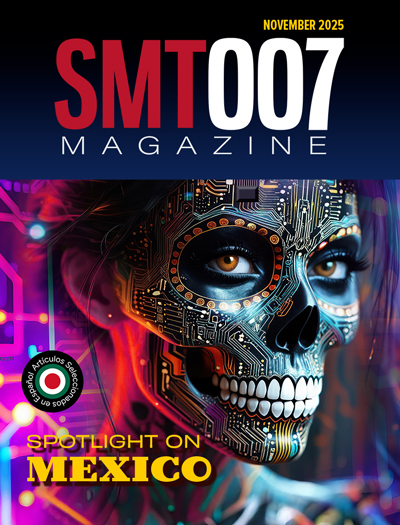-

- News
- Books
Featured Books
- smt007 Magazine
Latest Issues
Current Issue
Spotlight on Mexico
Mexico isn’t just part of the electronics manufacturing conversation—it’s leading it. From growing investments to cross-border collaborations, Mexico is fast becoming the center of electronics in North America. This issue includes bilingual content, with all feature articles available in both English and Spanish.

Production Software Integration
EMS companies need advanced software systems to thrive and compete. But these systems require significant effort to integrate and deploy. What is the reality, and how can we make it easier for everyone?

Spotlight on India
We invite you on a virtual tour of India’s thriving ecosystem, guided by the Global Electronics Association’s India office staff, who share their insights into the region’s growth and opportunities.
- Articles
Article Highlights
- Columns
- Links
- Media kit
||| MENU - smt007 Magazine
How to Streamline PCB Thermal Design
April 1, 2015 | John Parry, Mentor Graphics CorporationEstimated reading time: 2 minutes
Thermal issues with a PCB design are mostly determined during the component selection and layout phases. After this point, only remedial actions are possible if components are found to run too hot. Addressing thermal issues early in PCB design, starting at the system or enclosure level to understand the flow environment critical for air-cooled electronics, can streamline the process. Assumptions about the airflow uniformity in early design that subsequently prove unachievable can have a disastrous effect on the commercial viability of the product and meeting the market window.
Begin Before Placement and Layout
Substantial work can be done well before layout is completed within the electrical design flow. A simple representation of the enclosure can provide information about the air flow profile over the board. Start by smearing the total board power over the total board surface, which will provide a temperature map that will show any hot regions that are caused by a badly distributed air flow. Treat the board as a block with an isotropic conductivity of between 5 W/mK and 10 W/mK to optimize enclosure-level air flow ahead of the PCB design.
Components inject heat locally into the board so the heat flux density into the board below a component will be higher than the average for the board. As a result, the local board temperature will be higher than that predicted in the simulation. Refine the model before using the board temperature to estimate component temperatures. If the board temperature at any point is close to the maximum component case temperature, this limit will be exceeded once the component heat sources are represented discretely.
Guesstimate Component Power
At this stage, make a best-guess estimate of the individual power budgets for the main heat dissipating components that will be used in the design and the approximate size of those packages. This will enable describing them as footprint heat sources in the simulation, smearing the remainder of heat uniformly over the board surface.
Before Selecting the Package, Use 3D Component Models
Include some form of 3D component model in the simulation before the component selection is finalized. By feeding the thermal results back before this milestone is reached, the thermal performance will more likely be considered in the package selection criteria. Some ICs are available in more than one package style, and not all package styles perform equally well from a thermal point of view. The need for a heatsink later may be eliminated by appropriate package selection.
Component temperature, either in the form of a case temperature or junction temperature depending on how the manufacturer has specified the component, is the key measure used to indicate whether the design is thermally acceptable.
Editor's Note: This article originally appeared in the March issue of SMT Magazine.
Testimonial
"Our marketing partnership with I-Connect007 is already delivering. Just a day after our press release went live, we received a direct inquiry about our updated products!"
Rachael Temple - AlltematedSuggested Items
NEDME 2025 Draws Strong Northwest Crowd, Builds on Tradition of Regional Collaboration
10/31/2025 | NEDMEThe NW Electronics Design & Manufacturing Expo (NEDME) 2025 once again brought together the Pacific Northwest community for a full day of learning, networking, and industry connections.
Keysight Advances Quantum Engineering with New System-Level Simulation Solution
10/30/2025 | BUSINESS WIREKeysight Technologies, Inc. announced the release of Quantum System Analysis, a breakthrough Electronic Design Automation (EDA) solution that enables quantum engineers to simulate and optimize quantum systems at the system level.
WestDev Announces Advanced Thermal Analysis Integration for Pulsonix PCB Design Suite
10/29/2025 | WestDev Ltd.Pulsonix, the industry-leading PCB design software from WestDev Ltd., announced a major enhancement to its design ecosystem: a direct interface between Pulsonix and ADAM Research's TRM (Thermal Risk Management) analysis software.
Industry Veteran Dr. Helen Song Joins Celera Semiconductor to Lead Product Design
10/28/2025 | PRNewswireCelera Semiconductor, the analog industry leader using AI to automate the entire product development flow, today announced that Dr. Helen Song has joined the company as vice president of Product Design.
Mapping the EV Landscape: Markets, Platforms, and Powertrains
10/28/2025 | Stanton Rak, SF Rak Companye-Mobility is the defining transformation of 21st-century transportation. As legacy OEMs, startups, and governments race to electrify vehicle fleets, the landscape of e-Mobility is expanding into previously unimaginable territory. But with innovation comes complexity, and with complexity, a need for systems that are not only high-performing but also reliably engineered for the long haul. Understanding the diversity and scale of the EV marketplace is essential to grasping the reliability challenges ahead.


